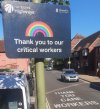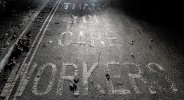I was thinking about how shopping patterns had changed, inspired by several posts on this thread, and remembered the village I grew up in - Mottram-in-Longdendale - with a population of about 1000 on the edge of Manchester in the 1960s. There were:
Small grocers/sweet shops
-Mr Burton
-Mrs Peel
-Auntie Beattie (properly Beatrice Shaw)
-Mr Beresford
Mr Flint the greengrocer
Joan Hulme the hairdresser
Greenwood’s bakery
The Post Office/Newsagent run by Mr Windred
The Chemist
Mr Hall the butcher
Another butcher (Malcolm something)
Wood’s ironmongers
Fish and chip shop
Malcolm Manifold the Blacksmith
The Co-op
Mrs Mills the haberdasher
Dr Clarke’s surgery
The Junction Inn
The White Hart
The Waggon and Horses
The Pack Horse
The Roe Cross
Two petrol stations (one of which repaired cars)
Today we have
The doctor’s surgery
The chemist
A hairdresser
Wood’s ironmongery, still in the family
Post Office and general store
A kitchen/bathroom centre in the old Co-op
Roe Cross was undergoing some sort of renovation last time I saw it.
Two petrol stations (both also selling groceries and drinks)
I’m not saying this is good or bad, but I wonder if older posters can remember similar changes to where they lived. To relate to the thread title, long live the anachronism of an ironmonger in such a modest settlement.
For a village of 1000 people that's a fair number of businesses to support!
My family moved to a small fishing village in 1980 with a population that was only slightly bigger. There were two "supermarkets" - one in an central location on the "high street" and one on the main road that ran along the top of the village (we'd class both as being "convenience stores" these days).
There was the Post Office which, in addition to its official functions, sold sweets (big jars on high shelves whose contents were weighed and then tipped into small paper bags - a "quarter" being the most common quantity requested), tobacco, newspapers and magazines along with a bit of tourist tat for visitors.
Over the road there was another small shop that also sold sweets from jars, along with a few grocery staples and ice lollies; Walls Mini-milk, Zoom and others that probably don't exist these days. Pot Noodles/Rice, still a relatively new concept, were also sold there. It had a really old-fashioned mechanical till that served no purpose other than to provide accommodation for the little cash that was taken; the proprietor would tot things up on a bit of paper and the only button that was used was "No Sale". If such a shop existed today, the first question I'd ask would be "why?!"
Heading back up the street, there was an antique/junk shop that seemed to have lots of stock but was never open. It was later taken over by a local solicitor and became an agent for the Halifax (I opened my Little Xtra account there); that was where one would wait for the free bus to Fine Fare. There was a baker's shop a few doors up that also sold general groceries (but not the same range as all the others).
There were also two butchers, a drapery, a chemist, the chip shop/cafe and two garages, one of which was also a coachbuilder.
Finally, there was the weird shop. This was definitely another "why?" shop that sold a few grocery items, along with various ornaments. The only way I can really describe it is by referring you to
The League of Gentlemen; I remember the shop being quite dark and the feeling of not really being welcome!




